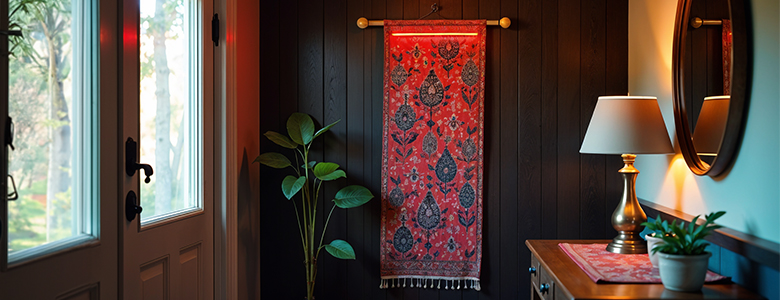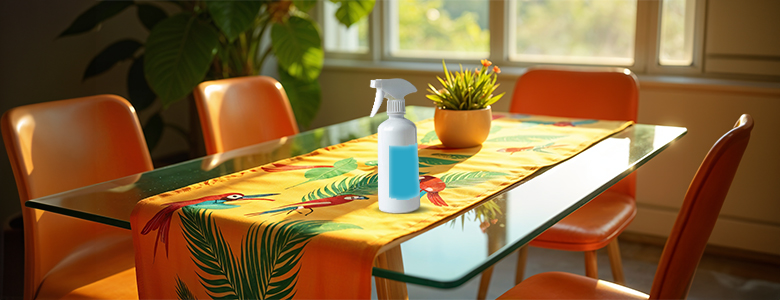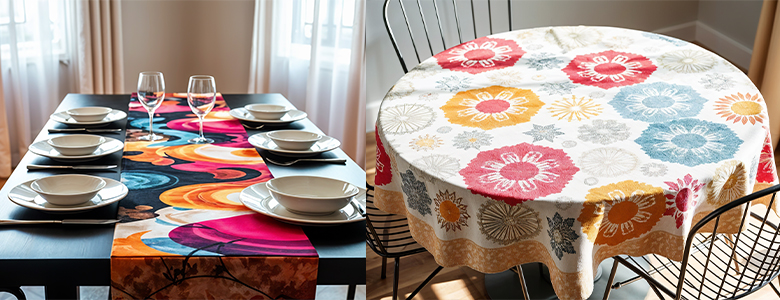1. Understanding the Fabric
Table runners come in various materials like cotton, linen, silk, and polyester, each with its unique care instructions. Ensure to always check the care label. Here’s a quick guide to some common materials:
Cotton: Usually machine washable with cold water and a gentle cycle.
Linen: Delicately washable fabric requiring hand wash or a gentle cycle.
Silk: Best suited for dry cleaning.
Polyester: Machine washed without much concern for shrinkage or damage.
2. Pre-Treat Stains Immediately
The key to preserving your table runner is to treat stains immediately:
Blot, Don’t Rub: Avoid rubbing the stain. Instead, blot gently with a paper towel or clean cloth to absorb the liquid.
Use a Gentle Stain Remover: For persistent stains, use a mild stain remover suitable for the fabric.
Avoid Bleach: It’s best to avoid bleach, as it can weaken the fabric and change colors.
3. Drying Your Table Runner
Drying techniques are equally important to maintain the integrity and appearance of your table runner:
Air Drying: It is ideal for runners made of cotton, linen, or silk. After washing, lay it flat on a clean towel and gently press out the excess water. Avoid direct sunlight to prevent fading.
Avoiding Heat Drying: Machine dryers are generally not recommended for table runners, as the heat can cause shrinkage or damage. Even if you use it, choose a low heat setting and place the runner in a protective bag.
Ironing: Once dry, iron your table runner on a low heat setting, particularly if it’s made of linen or cotton. Silk and delicate fabrics should be ironed on the reverse side with a cloth in between to prevent burns.
4. Storage Tips to Keep Your Runner Looking Fresh
Proper storage is key to maintaining the shape and quality of your table runner:
Avoid Folding: Folding can lead to creases that are hard to remove. Instead, roll the runner loosely and store it.
Use Tissue Paper: For delicate fabrics like silk, place sheets of tissue paper between folds to prevent wrinkles and friction that might damage the fabric.
Store in a Dry Place: Store your table runner in a cool, dry area to avoid moisture buildup. Avoid storing it in plastic, as this can trap moisture and cause fabric deterioration.
5. Seasonal Rotation and Refreshing Tips
Rotate your table runners seasonally to prevent excess wear on any one side and keep your decor fresh. When using stored table runners, refresh it by light ironing before placing it on the table. For runners with stubborn wrinkles, a quick mist of water and gentle pressing is required.
6. Special Tips for Decorated Table Runners
If your runner is embellished with beads, lace, or sequins, extra care is needed:
Gentle Cleaning: Opt for hand washing or dry cleaning to protect embellishments from damage.
Avoid Direct Contact with Hot Surfaces: Decorative runners can sometimes melt or warp when exposed to heat.
Conclusion
With proper care and cleaning, your table runner can continue to enhance your dining area for years to come. Start by understanding the fabric, promptly treating stains, washing with care, drying properly, and storing thoughtfully. These simple steps ensure your table runner remains as beautiful as the day you bought it, ready to elevate every meal or celebration.









